Daugavpils
Daugavpils (see also other names) is a state city in south-eastern Latvia, located on the banks of the Daugava River, from which the city gets its name.[3] The parts of the city north of the river belong to the historical Latvian region of Latgale, and those to the south lie in Selonia. It is the second-largest city in the country after the capital Riga, which is located some 230 kilometres (143 miles) to its north-west.[3]
Daugavpils | |
|---|---|
State city | |
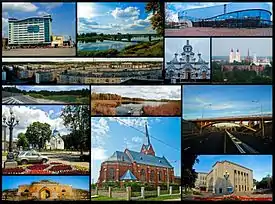 City from different points of view | |
 Flag  Coat of arms | |
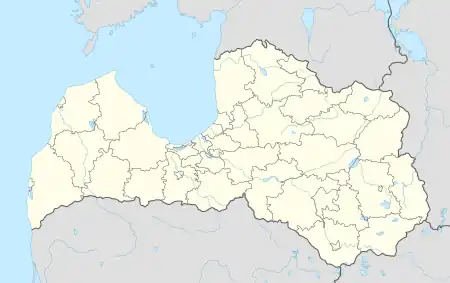 Daugavpils Location of Daugavpils in Latvia | |
| Coordinates: 55°52′30″N 26°32′8″E | |
| Country | Latvia |
| Established | 1275 |
| Town rights | 1582 |
| Government | |
| • Chairman of the City Council | Andrejs Elksniņš (Harmony) |
| • Number of city council members | 15 |
| Area | |
| • State city | 72.37 km2 (27.94 sq mi) |
| • Land | 63.38 km2 (24.47 sq mi) |
| • Water | 8.99 km2 (3.47 sq mi) |
| Highest elevation | 139 m (456 ft) |
| Lowest elevation | 86 m (282 ft) |
| Population (2023)[2] | |
| • State city | 78,850 |
| • Rank | 2 |
| • Density | 1,100/km2 (2,800/sq mi) |
| • Metro | 105,047 (with Augšdaugava Municipality) |
| Time zone | UTC+2 (EET) |
| • Summer (DST) | UTC+3 (EEST) |
| Postal code | LV-54(01–65) |
| Calling code | (+371) 654 |
| Climate | Dfb |
| Website | www |
Daugavpils is located relatively close to Belarus and Lithuania (distances of 33 km (21 mi) and 25 km (16 mi) respectively), and some 120 km (75 mi) from the Latvian border with Russia. Daugavpils is a major railway junction and industrial centre and was an historically important garrison city lying approximately midway between Riga and Minsk, and between Warsaw and Saint Petersburg.
Daugavpils, then Dyneburg, was the capital of Polish Livonia while in Polish–Lithuanian Commonwealth. Following the first partition of Poland in 1772, the city became part of the Russian Empire.[3] Since the Second World War, it has maintained an overwhelmingly Russian-speaking population, with Latvians and Poles being significant minorities. Historically, German and Yiddish were additional prominent native languages.
Names
In the Latvian language, the current name Daugavpils (Latvian pronunciation: [ˈdauɡaupils] ⓘ) references Daugava and the Latvian word pils (meaning "castle" - cognate with Lithuanian pilis, with Greek polis[4] and with Old Prussian pils[5]).
Historically, several names in various languages have identified Daugavpils. Some are still in use today.
- Belarusian: Даўґаўпілс (Daŭgaŭpils); historically Дзвінск (Dzvinsk),[nb 1] Дынабурґ (Dynaburg)
- German: Dünaburg[6] (German pronunciation: [ˈdyːnaˌbʊʁk] ⓘ)
- Estonian: Düünaburg, Väinalinn
- Finnish: Väinänlinna
- French: Dunebourg, Dimmebourg
- Latgalian: Daugpiļs, [ˈdaʊkʲpʲilʲsʲ]
- Lithuanian: Daugpilis
- Polish: Dzwińsk, Dyneburg
- Russian: Даугавпилс; historically: Невгин (Nevgin), Динабург (Dinaburg), Борисоглебск (Borisoglebsk), Двинск (Dvinsk)
- Yiddish: דענענבורג (Denenburg), דינאַבורג (Dinaburg), דווינסק (Dvinsk)
Chronology of name changes
- Dünaburg (1275–1656)
- Borisoglebsk (1656–1667)
- Dünaburg (1667–1893)
- Dvinsk (1893–1920)
- Daugavpils (since 1920)
History
_early_20th_century.jpg.webp)
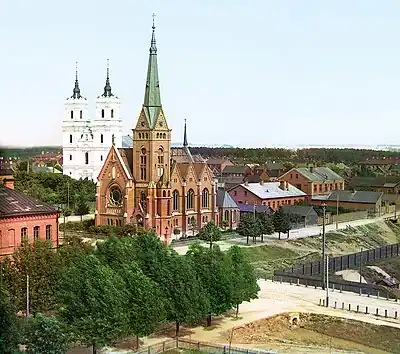
The town's history began in 1275 when the Livonian Order, led by Ernst von Ratzeburg, built Dünaburg Castle 20 km (12 mi) up the Daugava river from where Daugavpils is now situated.[3] In 1561 it became part of the Grand Duchy of Lithuania and, subsequently, of the Polish–Lithuanian Commonwealth in 1569 (see Duchy of Livonia). In 1621 Daugavpils became the capital of the newly formed Inflanty Voivodeship, which existed until the First Partition of Poland (1772). In 1577 the Russian tsar Ivan the Terrible captured and destroyed Dünaburg castle. That same year, a new castle and a town were built 20 km (12 mi) downriver, by the Polish King Stephen Báthory. In 1582 Daugavpils was granted Magdeburg town rights. In the 17th century, during the Russo-Swedish War initiated by Tsar Alexis of Russia, the Russians captured Daugavpils, renamed the town Borisoglebsk and controlled the region for 11 years, between 1656 and 1667. Russia returned the area to Polish–Lithuanian Commonwealth following the Treaty of Andrusovo (1667). It became part of the Russian Empire after First Partition of Poland in 1772. It was an uyezd center firstly in Pskov Governorate between 1772 and 1776, Polotsk one between 1776 and 1796, Belarus one between 1796 and 1802 and finally Vitebsk between 1802 and 1917 as Dinaburg firstly, as Dvinsk later during Russian rule.
From 1784 onwards the city had a large and active Jewish population[7] among them a number of prominent figures. According to the Russian census of 1897, out of a total population of 69,700, Jews numbered 32,400 (ca. 44% percent).[8]
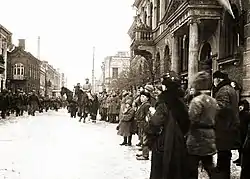
As part of the Russian Empire, the city was called Dvinsk from 1893 to 1920. The newly independent Latvian state renamed it Daugavpils in 1920. Latvians, Poles and Soviet troops fought the Battle of Daugavpils in the area from 1919 to 1920. Daugavpils and the whole of Latvia was under Soviet rule between 1940–41 and 1944–1991. Nazi Brandenburgers led the German attack against the town in 1941, speaking Russian and wearing Soviet uniforms, and Germany occupied it between 1941 and 1944. The Nazis established the Daugavpils Ghetto where the town's Jews were forced to live. Most were murdered. During the Cold War the Lociki air-base operated 12 km (7 mi) northeast of Daugavpils itself. In the late Soviet era, there was a proposal to build a hydroelectric power station on the Daugava river that was successfully opposed by the nascent environmental movement in Latvia.
On 16 April 2010 an assassin shot vice-mayor Grigorijs Ņemcovs in the center of the city. He died almost immediately and the crime remains unsolved.[9]
Jewish history
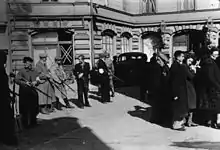
Prior to 1941, Daugavpils, called Dvinsk by its Jewish inhabitants, was home to the most prominent Jewish community in eastern Latvia. The city was already a Jewish center as early as the 1780s and by the time of the 1897 census, they numbered 32,400 (44% of the overall population of the city). By 1911 they had increased to 50,000. The Jews of the town were very prosperous and ran 32 factories and there were 4000 artisans among them.
The city not only boasted a large Jewish population but a rich religious culture including 40 synagogues. The city was home to two of the most prominent rabbis of their time: Joseph Rosen (1858–1936), known as the Rogatchover Gaon (genius from Rahachow), was famed for his commentaries on the works of Maimonides and on the Talmud. Famed for his acidic wit and penetrating genius, he led the towns Hasidic Jews. His 'competitor', the leader of the local Misnagdim (non-Hasidic Jews) was the Rabbi Meir Simcha of Dvinsk (1843–1926). Rabbi Meir Simcha was also renowned for his work on Maimonides (Or Somayach) as well as Bible commentary Meshech Chochma. In one famous comment he predicted that since some Jews had assimilated and viewed Berlin as their 'Jerusalem' they would suffer persecution originating in Berlin.
Another famous Jewish resident was the abstract expressionist painter Mark Rothko. Born in Daugavpils in 1903 he immigrated at the age of 10 to the United States where he painted over 800 paintings in his unique style.
In the last census taken prior to the Second World War, in 1935, the Jewish population of Daugavpils numbered 11,106 (24.6% of the overall population of the city).[10]
Jewish Daugavpils, a 16,000 strong community, came to an end following the Nazi German invasion on 26 June 1941. Falsely claiming that the Jews had conspired to set fire to the town and that they were assisting the Soviet army, the Germans and their Latvian collaborators carried out large executions on 28–29 June. During July the Jews were enslaved and forced to cut down timber. On 7–11 July Einsatzkommando 1b under Erich Ehrlinger executed many of the remaining Jews. Later in July the 14,000 remaining Jews were forced into a Ghetto along with those from nearby towns. By the end of August an additional 7000 Jews had died at the hands of the Nazis and the local Latvian collaborators. The largest execution took place in November 1941 and was followed by plagues that decimated the few survivors. Only about 1500 Jews remained in the city. These were murdered on 1 May 1942. When the town was liberated in 1944 only 100 survivors remained of a community of 16,000. For more on the Holocaust in Daugavpils see Daugavpils Ghetto.
Geography
Climate
The city has a continental climate with warm summers and cold winters. Under the Köppen climate classification, Daugavpils features a humid continental climate (Dfb).
| Climate data for Daugavpils (1991−2020 normals, extremes 1891−present) | |||||||||||||
|---|---|---|---|---|---|---|---|---|---|---|---|---|---|
| Month | Jan | Feb | Mar | Apr | May | Jun | Jul | Aug | Sep | Oct | Nov | Dec | Year |
| Record high °C (°F) | 11.1 (52.0) |
13.1 (55.6) |
18.4 (65.1) |
27.4 (81.3) |
31.8 (89.2) |
33.1 (91.6) |
35.1 (95.2) |
33.5 (92.3) |
31.3 (88.3) |
23.6 (74.5) |
16.3 (61.3) |
10.6 (51.1) |
35.1 (95.2) |
| Mean maximum °C (°F) | 4.6 (40.3) |
5.1 (41.2) |
12.1 (53.8) |
22.1 (71.8) |
26.4 (79.5) |
28.1 (82.6) |
30.2 (86.4) |
29.3 (84.7) |
24.4 (75.9) |
17.8 (64.0) |
10.4 (50.7) |
6.2 (43.2) |
31.4 (88.5) |
| Average high °C (°F) | −1.8 (28.8) |
−1.1 (30.0) |
4.0 (39.2) |
12.2 (54.0) |
18.1 (64.6) |
21.4 (70.5) |
23.7 (74.7) |
22.5 (72.5) |
17.0 (62.6) |
9.9 (49.8) |
3.6 (38.5) |
−0.2 (31.6) |
10.8 (51.4) |
| Daily mean °C (°F) | −4.1 (24.6) |
−4.1 (24.6) |
0.0 (32.0) |
6.7 (44.1) |
12.2 (54.0) |
15.8 (60.4) |
18.1 (64.6) |
16.8 (62.2) |
11.9 (53.4) |
6.3 (43.3) |
1.5 (34.7) |
−2.2 (28.0) |
6.6 (43.8) |
| Average low °C (°F) | −7.0 (19.4) |
−7.7 (18.1) |
−4.3 (24.3) |
1.1 (34.0) |
5.7 (42.3) |
9.7 (49.5) |
12.1 (53.8) |
11.0 (51.8) |
7.0 (44.6) |
2.7 (36.9) |
−0.8 (30.6) |
−4.5 (23.9) |
2.1 (35.8) |
| Mean minimum °C (°F) | −21.7 (−7.1) |
−21.0 (−5.8) |
−13.9 (7.0) |
−5.9 (21.4) |
−1.6 (29.1) |
3.4 (38.1) |
6.9 (44.4) |
4.8 (40.6) |
−0.4 (31.3) |
−5.1 (22.8) |
−10.0 (14.0) |
−14.9 (5.2) |
−25.7 (−14.3) |
| Record low °C (°F) | −42.7 (−44.9) |
−43.2 (−45.8) |
−32.0 (−25.6) |
−18.6 (−1.5) |
−5.5 (22.1) |
−1.3 (29.7) |
2.1 (35.8) |
−1.5 (29.3) |
−5.0 (23.0) |
−14.7 (5.5) |
−24.1 (−11.4) |
−38.7 (−37.7) |
−43.2 (−45.8) |
| Average precipitation mm (inches) | 40.3 (1.59) |
38.7 (1.52) |
35.5 (1.40) |
34.6 (1.36) |
61.6 (2.43) |
74.2 (2.92) |
72.9 (2.87) |
71.7 (2.82) |
56.1 (2.21) |
58.6 (2.31) |
48.4 (1.91) |
42.8 (1.69) |
635.4 (25.03) |
| Average precipitation days (≥ 1.0 mm) | 9.6 | 7.7 | 8.5 | 8.0 | 9.2 | 9.9 | 11.1 | 10.2 | 11.7 | 9.8 | 11.4 | 11.9 | 119.0 |
| Mean monthly sunshine hours | 35.1 | 62.2 | 133.4 | 195.1 | 270.2 | 271.9 | 277.2 | 244.5 | 156.4 | 87.9 | 30.5 | 24.9 | 1,789.3 |
| Source 1: LVĢMC[11][12] | |||||||||||||
| Source 2: NOAA (precipitation days 1961–1990)[13] Infoclimat[14] | |||||||||||||
Demographics
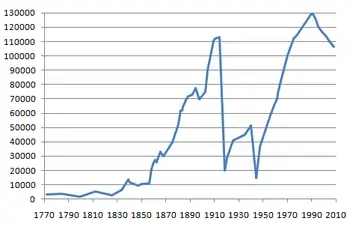
As of 1 January 2020, the city had a population of 82,046.[15] In Daugavpils 85% of the voters supported the proposal to make Russian the second state language in the 2012 referendum.[16]
Religion
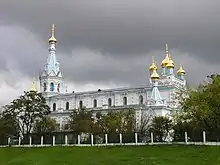
Church Hill (Baznīcu kalns) is a city landmark. Very prominently, all of the main denominations practiced in Latvia: Lutheran, Catholic, Orthodox and Old Believer are represented.
Places of worship in the city:
- Martin Luther Cathedral
- Ss. Boris and Gleb Cathedral
- St. Alexander Nevsky Cathedral
- St. Alexander Nevsky Church
- Immaculate Conception Catholic Church
- St. Peter-in-Chains Catholic Church
- Heart of Jesus Catholic Church
- Grīva Catholic Church
- First Old Believers’ House of Prayer
- Vecforštate Old Believers' House of Prayer
- Daugavpils Synagogue - restored 2003-2006
Before the Second World War, there were more than 40 synagogues in the city.
Art, architecture, and culture
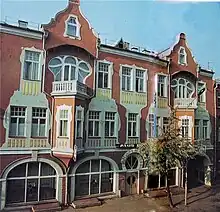
Daugavpils is an important cultural centre in eastern Latvia. There are 22 primary and secondary schools, four vocational schools, and the Saules College of Art. More than 1,000 teachers and engineers graduate from the University of Daugavpils (formerly Daugavpils Pedagogical University) and the local branch of Riga Technical University annually. There is also a Polish gymnasium (academic secondary school) on Varšavas iela (Warsaw Street).
Historical centre
The historical centre of Daugavpils city is an architectural heritage of national importance (the construction work was carried out in the 19th century according to the project endorsed in St Petersburg in 1826). The historical centre is the greatest attraction of the city and one of the most successful examples of balancing the aspects of ancient and modern times. Daugavpils is one of the few cities in Latvia which can pride itself on a unified ensemble of both classic and eclectic styles. The cultural heritage of architectural, artistic, industrial, and historical monuments combined with the picturesque surroundings create the essence of Daugavpils’ image and endow it with a special charm.
In 2020 the municipality allocated 70,000 euros for the restoration of eight historical buildings, including Art Nouveau and red brick buildings.[18]
There are also several architectural, historical, and cultural monuments in Daugavpils. The most prominent are:
- Daugavpils fortress - dating mostly from the 18th and 19th centuries. In April 2013 the Mark Rothko Art centre was opened in the fortress.
- Daugavpils Theatre - built in 1937-1938 by Verners Vitands and restored in 2007.
- St. Peter-in-Chains Catholic Church - the oldest preserved church in the city, built in 1845-1848 and rebuilt in 1924-1934.
- Church Hill (Baznīci kalnas) - place where the churches of four christian denominations are located next to each other: Immaculate Conception Catholic Church, Martin Luther Cathedral, Ss. Boris and Gleb Cathedral and First Old Believers’ House of Prayer.
Red brick buildings
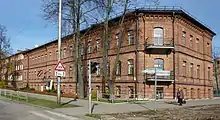
Daugavpils is exceptionally rich in red brick buildings. This style was developed by many outstanding architects. In Daugavpils, this variety of eclecticism is most widely represented in the buildings designed by Wilhelm Neumann, an architect of German origin who was the chief architect of the city from 1878 to 1895. Bright examples of brick architecture are the buildings at 1/3 Saules Street and at 8 Muzeja Street. The shape-forming techniques typical of eclecticism that were applied in the façades of these buildings even many decades later make one appreciate and admire the striking accuracy of detail.
Transport
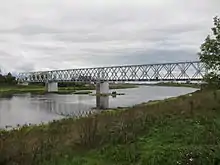
Daugavpils satiksme AS oversees the city's bus and tram networks.
The city's railway station is the terminus of the Riga–Daugavpils Railway. There is a train connection to Vilnius during the weekends.
A former Soviet Air Force base is located at Lociki 12 km (7 mi) northeast of downtown Daugavpils with the potential to be redeveloped as a civilian or military/civilian airport, although no plans have come to fruition as of 2023.[19][20][21] Griva Airfield is located 4 km NW of Daugavpils, next to the river. It's movements mainly involve parachute jumping and paragliding.[22]
Government
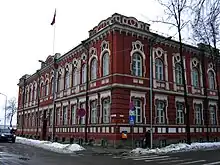
The head of the city government is the mayor of Daugavpils or, literally, 'Council Chairman' (domes priekšsēdētājs). The incumbent since January 2019 is Andrejs Elksniņš from Harmony, albeit coalition talks are still ongoing. It is his second term in office, after his initial term was ended after the coalition broke apart in September 2017 less than a month following the 2017 municipal elections and he was succeeded by Rihards Eigims of the Latvian Green Party (elected on the "Our Party" electoral list). "Our Party" governed in coalition with the Latgale Party of the previous mayor Jānis Lāčplēsis. Eigims was previously mayor from 2001–2003 as leader of the Light of Latgale party and briefly in 2009 as a member of the Latvian Social Democratic Workers' Party.
The Council consists of 15 members who are elected every four years. The most recent election was in 2017.
Economy
Significant industrial employers include the Daugavpils Locomotive Repair Plant (Daugavpils Lokomotīvju Remonta Rūpnīca), the Ditton Driving Chain Factory (Ditton pievadķēžu rūpnīca), Latvijas Maiznieks bread factory and the Ziegler GmbH machine works.
During the Soviet era, the city was well industrialised with a number of prominent large manufacturing units. However, nowadays only a few of those have remained still working. The city council is trying to attract new investments and thus created a number of free industrial zones around the whole city that might be interesting due to the strategically efficient geographical position of the city close to the Russian, Belarusian and Lithuanian borders.
Sports
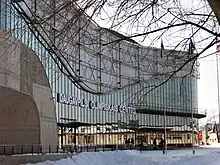
The Speedway Grand Prix of Latvia is currently held at the Latvijas Spīdveja Centrs with America's triple World Champion Greg Hancock being the most successful rider in Latvia winning the GP in 2009, 2009 and 2013. Lokomotiv Daugavpils is a Motorcycle speedway team which successfully competes in the Polish league system.
The football clubs FC Daugava and BFC Daugavpils play at Celtnieks Stadium in Daugavpils. Both teams plays in the Latvian Higher League. In the past there was Dinaburg FC which played at the former Daugava Stadium.
FBC Latgale represent the city in floorball. There is also a hockey team called HK Dinaburga, which currently plays in the Latvian Hockey Higher League.
In 2008 the construction of the Daugavpils Multifunctional Sports Complex was started and was completed in October 2009.
Notable residents
- Andris Ambainis (born 1975), Latvian computer scientist
- Konstantīns Calko (born 1994), Latvian racing driver
- Aleksandrs Cauņa (born 1988), Latvian footballer
- Teresa Czerwińska (born 1974), Polish economist, Minister of Finance of Poland (2018–)
- Leonid Dobychin (1894–1936), Russian writer
- Movsas Feigins (Movša Feigins, 1908–1950), Latvian chess master
- Grzegorz Fitelberg (1879–1953), Polish composer and conductor
- Isser Harel (born Isser Halperin) (c. 1912–2003), Israeli spymaster
- Kastuś (Kanstancin) Jezavitaŭ (1893–1946), political and military leader within the Belarusian independence movement[23]
- Gotthard Kettler (1517–1587), last Master of the Livonian Order and the first Duke of Courland and Semigallia
- Abraham Isaac Kook (1864–1935), rabbi, thinker, diplomat, mediator, scholar
- Pinchas HaKohen Lintup (1851–1924), rabbi and Kabbalist
- Solomon Mikhoels (1890–1948), Soviet Jewish actor and director
- Viktoria Modesta (born 1988), Latvian-born British singer-songwriter, performance artist, and model
- Grigorijs Ņemcovs (1948–2010), Latvian journalist, businessman and politician
- Nicolai Poliakoff OBE (1900–1974), creator of Coco the Clown
- Władysław Raginis (1908–1939), Polish officer
- Rogatchover Gaon (1858–1936), rabbi
- Mark Rothko (1903–1970), American abstract expressionist painter
- Isaak Illich Rubin (1886–1931), Jewish political economist and socialist activist
- Artjoms Rudņevs (born 1988), Latvian footballer
- Uļjana Semjonova (born 1952), basketball player
- Meir Simcha of Dvinsk (1843–1926), rabbi
- Isaac Nachman Steinberg (1888–1957), writer, politician, co-founder of the Freeland League
- Władysław Studnicki (1867–1953), Polish politician and publicist
- Stanisław Swianiewicz (1899–1997), Polish economist and historian
- Deniss Vasiļjevs (born 1999), Latvian figure skater
- Vitas (born 1979), Russian singer, songwriter, composer, actor and fashion designer
Twin towns – sister cities
Daugavpils is twinned with:[24]
 Alaverdi, Armenia
Alaverdi, Armenia Babruysk, Belarus
Babruysk, Belarus Batumi, Georgia
Batumi, Georgia Central Administrative Okrug (Moscow), Russia
Central Administrative Okrug (Moscow), Russia Ferrara, Italy
Ferrara, Italy Harbin, China
Harbin, China Kharkiv, Ukraine
Kharkiv, Ukraine Lida, Belarus
Lida, Belarus Magdeburg, Germany
Magdeburg, Germany Motala, Sweden
Motala, Sweden Naro-Fominsk, Russia
Naro-Fominsk, Russia Panevėžys, Lithuania
Panevėžys, Lithuania Pskov, Russia
Pskov, Russia Radom, Poland
Radom, Poland Ramla, Israel
Ramla, Israel Saint Petersburg, Russia
Saint Petersburg, Russia Vagharshapat, Armenia
Vagharshapat, Armenia Vitebsk, Belarus
Vitebsk, Belarus
Gallery
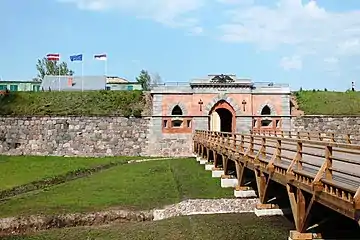 Nicholas Gate at Daugavpils Fortress
Nicholas Gate at Daugavpils Fortress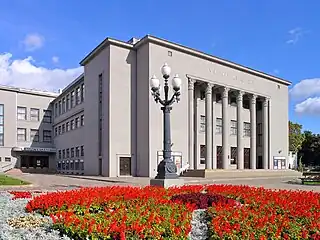 Unity House contains Daugavpils Theatre and a recreation centre
Unity House contains Daugavpils Theatre and a recreation centre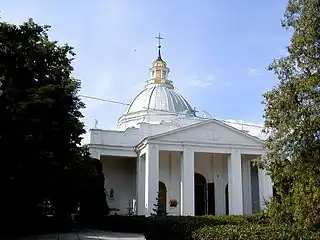 St. Peter-in-Chains Catholic Church
St. Peter-in-Chains Catholic Church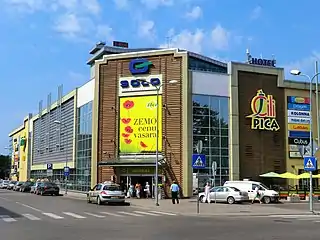 'Solo' shopping centre
'Solo' shopping centre.jpg.webp) Art Nouveau building
Art Nouveau building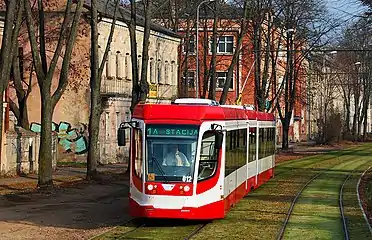 Tram
Tram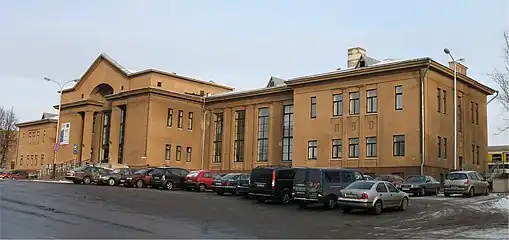 Train station
Train station.jpg.webp) City centre
City centre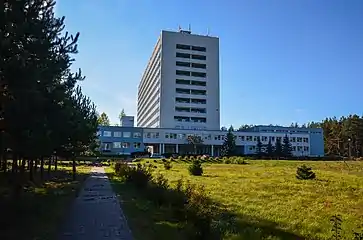 Regional hospital
Regional hospital.jpg.webp) Fire station
Fire station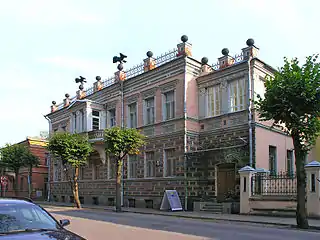 Museum
Museum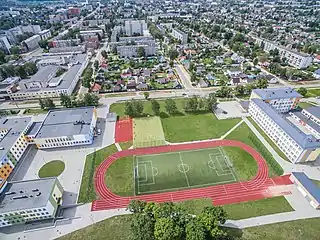 School
School
Significant depictions in popular culture
- Dunaburg (Daugavpils) is one of the starting towns of the State of the Teutonic Order in the turn-based strategy game Medieval II: Total War: Kingdoms.[25]
See also
Notes
- In Taraškievica it is spelled Дзьвінск (Dźvinsk),
References
- "Reģionu, novadu, pilsētu un pagastu kopējā un sauszemes platība gada sākumā". Central Statistical Bureau of Latvia. Retrieved 18 January 2023.
- "Iedzīvotāju skaits pēc tautības reģionos, pilsētās, novados, pagastos, apkaimēs un blīvi apdzīvotās teritorijās gada sākumā (pēc administratīvi teritoriālās reformas 2021. gadā) 2021 - 2022". Central Statistical Bureau of Latvia. Retrieved 2 October 2023.
- "History". Daugavpils.lv. Retrieved 29 March 2022.
- pils
- Rantawa.org. "Prūsisks wirdeīns". Prūsisks wirdeīns. Retrieved 2023-08-31.
- Rene Levoll: "The last motor race of the empire (ee: Impeeriumi viimane motovõistlus, de: Das letzte Autorennen des Imperiums)", Tallinn 2014, Estonian Old Technics Museum Foundation, page 81 "list of former and present place names of places"
- "Jewish families of Dvinsk". jewishgen.org. Retrieved 2008-07-12.
- Joshua D. Zimmerman, Poles, Jews, and the politics of nationality, Univ of Wisconsin Press, 2004, ISBN 0-299-19464-7, Google Print, p.16
- "Nošauts Daugavpils vicemērs Grigorijs Ņemcovs" (in Latvian). tvnet.lv. 2010-04-16. Retrieved 2010-04-30.
- Latvian Population Census - 1935, Part 4, Nationalities
- "Klimatisko normu dati" (in Latvian). Latvian Environment, Geology and Meteorology Centre. Retrieved March 19, 2023.
- "Gaisa temperatūras rekordi" (in Latvian). Latvian Environment, Geology and Meteorology Centre. Retrieved March 19, 2023.
- "Daugavpils Climate Normals 1961–1990". National Oceanic and Atmospheric Administration. Retrieved November 28, 2015.
- "Climatologie de l'année à Daugavpils" (in French). Infoclimat. Retrieved 26 October 2023.
- "RESIDENT POPULATION BY STATISTICAL REGION, CITY AND COUNTY". Centrālā statistikas pārvalde. Retrieved 29 May 2020.
- cvk.lv, 18.02.2012
- "Ethnic composition: 2019 estimation". Retrieved 17 July 2022.
- "Daugavpils to spend 70,000 on historical restorations". Public Broadcasting of Latvia. 21 February 2020. Retrieved 23 March 2020.
- "Daugavpils |". Daugavpils.lv. Retrieved 2011-09-15.
- "Daugavpils |". Daugavpils.lv. Retrieved 2011-09-15.
- "Pašvaldība lemj par SIA "Daugavpils lidosta" likvidāciju" (in Latvian). Daugavpils.lv. 15 July 2021. Retrieved 20 February 2023.
- "Griva (14/32) |". Retrieved 2021-12-31.
- Jezavitaŭ Kanstantyn
- "Sadraudzības pilsētas". daugavspils.lv (in Latvian). Daugavpils. Retrieved 2019-08-30.
- "The Teutonic Order (M2TW-K-TC faction)". wiki.totalwar.com. Retrieved 27 November 2019.
External links
- Information portal (in Russian)
- Information-entertaining portal (in Russian)
 Daugavpils travel guide from Wikivoyage
Daugavpils travel guide from Wikivoyage- Enterprises of Daugavpils
- The murder of the Jews of Daugavpils during World War II, at Yad Vashem website.
- Daugavpils, Latvia at JewishGen
- Daugavpils City Government (in English)